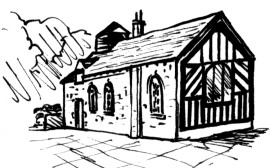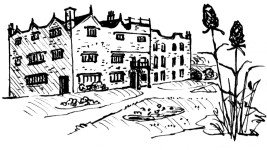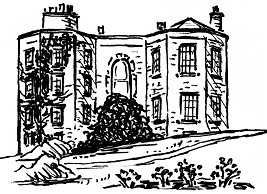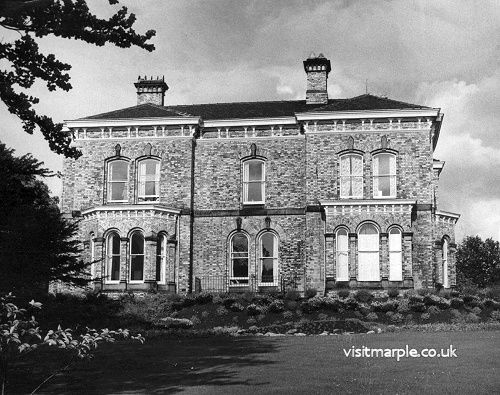 Marple, or Merpel as it was written when the name first appeared on the pages of history, was omitted from the Domesday Survey made by William I in 1086 probably being a waste land inside the boundary of Macclesfield Forest. The name of Marple is believed to be derived from either maere hop hyll meaning "The hill at the boundary valley" or maere pill "The stream at the boundary".
Marple, or Merpel as it was written when the name first appeared on the pages of history, was omitted from the Domesday Survey made by William I in 1086 probably being a waste land inside the boundary of Macclesfield Forest. The name of Marple is believed to be derived from either maere hop hyll meaning "The hill at the boundary valley" or maere pill "The stream at the boundary".
- Details
- Hits: 22068
An unusual artefact comes home to Marple
Every now and then an Internet search comes up trumps for all involved! In October 2022 Fred Duthy in Sweden was clearing out a box of his grandmother's stuff and found a tiny metal cylinder around 2cm diameter and 5cm long. On it was engraved the following inscription:
Frederick Booth
from
Miss Hudson
on completion of 50 years
of faithful service.
Brabyns 1860 – 1910
- Details
- Hits: 3204
Listen to The Marple Band on BBC Radio 2 in 1996
Every now and then something unusual is donated to Marple Local History Society Archives. In this case, former Marple Librarian Margaret Bradbury decided to pass on a cassette tape that she'd had for a very long time.
It was a recording made way back in 1996 featuring The Marple Band on Radio 2's Listen to the Band, and you can listen again now!
- Details
- Hits: 3202
Marple Rose Queens 1934-35
 In October 2020 a gentleman called Dave Watson sent me some photos that featured his mother, Joan Hope, as a young girl and also a couple of newspaper cuttings. The subjects were a 1934 pantomime at the Albert Schools and two Rose Queen events held at the Albert Schools and Rose Hill House in 1934-35.
In October 2020 a gentleman called Dave Watson sent me some photos that featured his mother, Joan Hope, as a young girl and also a couple of newspaper cuttings. The subjects were a 1934 pantomime at the Albert Schools and two Rose Queen events held at the Albert Schools and Rose Hill House in 1934-35.
- Details
- Hits: 5480
Francis Brindley and the Marple Brindleys - by Noel Brindley
Francis was my 4 x great grandfather and I believe that I and my two sons are his only direct ancestors. I eventually came across Francis after I'd asked my father, Charles Brindley, to tell me as much as he could about our Brindley family. My father did not know about Francis but he managed to spark an interest in me to look further at my family's history.
I first came across Francis through the IGI (International Genealogist Index) website as being the father of Thomas Brindley of Marple. This was confirmed by a Brindley genealogist, Gordon Brindley. I then found his Will on the East Cheshire council web site. Through this I discovered his profession, where he lived and the property and land he had owned in Marple. I found the website e-mapping Victorian Cheshire invaluable in confirming what I had learnt from the Will. I found out more about the company Francis Brindley & Co. from Tony Bonson, a mill expert interested in mills and waterways.
The best finds of all were on the Marple Website's Virtual Tour, where there were actually pictures of Marple Corn (mineral) Mill and Greenbank House, all once owned or occupied by Francis Brindley.
- Details
- Hits: 9559
Woodville Hall - Memories of a Wartime Evacuee
87 year old Vera stayed with Mrs Barlow at Woodville Hall in 1939
I never see anything about what Mrs Barlow of Woodville did at the outbreak of the war when my two younger sisters and I and my best friend and her younger sister were evacuated out of Manchester centre with the rest of the pupils of our school. Mrs Barlow took all five of us into her home and we were treated like we were her own. As you can imagine it was a very different life to what we were used to as children of working class parents. It was a beautiful home and we all enjoyed being there.
- Details
- Hits: 8015
Subcategories
Marple Hall
 Marple Hall is probably Marple's greatest historical loss. If it had survived a few more years it may have become a tourist attraction like Bramhall Hall but sadly that was not to be and all we can do today is speculate what might have been. However, at least you can at least take a Guided Tour of the hall through these pages and learn something about the incredible history that helped shape the community we live in today and discover a few relics that people managed to save.
Marple Hall is probably Marple's greatest historical loss. If it had survived a few more years it may have become a tourist attraction like Bramhall Hall but sadly that was not to be and all we can do today is speculate what might have been. However, at least you can at least take a Guided Tour of the hall through these pages and learn something about the incredible history that helped shape the community we live in today and discover a few relics that people managed to save.
Samuel Oldknow
 Samuel Oldknow came to this district in 1787 and remained for over 40 years, until his death at the age of 72. During this time he changed the face of Marple beyond all recognition, being the chief architect and driving force in the development and industrialisation of the area. Along with his mill at Mellor he was responsible for the building of roads, bridges, coal mines and housing for his workers. He was also instrumental in the construction of the Peak Forest Canal. A monument to him, placed in the Church he built to replace the old Chapel that had become too small for the expanding community, gives a clear indication of his standing and influence.
Samuel Oldknow came to this district in 1787 and remained for over 40 years, until his death at the age of 72. During this time he changed the face of Marple beyond all recognition, being the chief architect and driving force in the development and industrialisation of the area. Along with his mill at Mellor he was responsible for the building of roads, bridges, coal mines and housing for his workers. He was also instrumental in the construction of the Peak Forest Canal. A monument to him, placed in the Church he built to replace the old Chapel that had become too small for the expanding community, gives a clear indication of his standing and influence.






